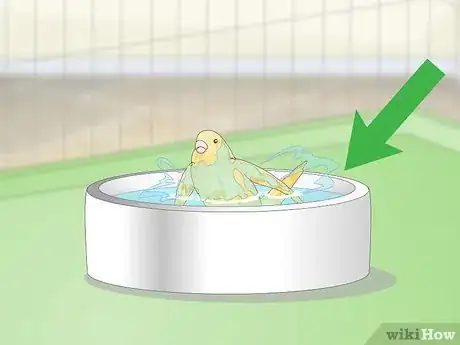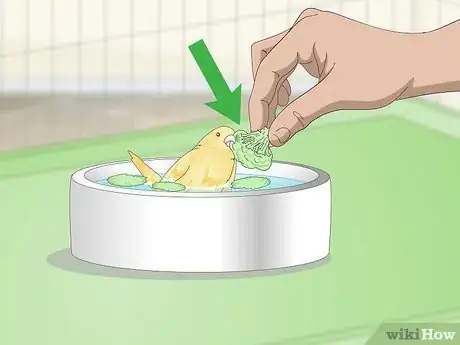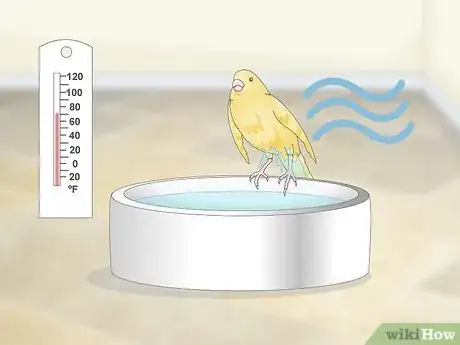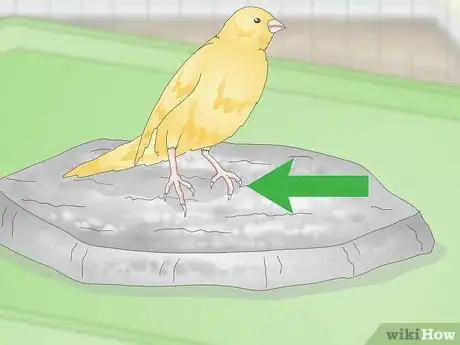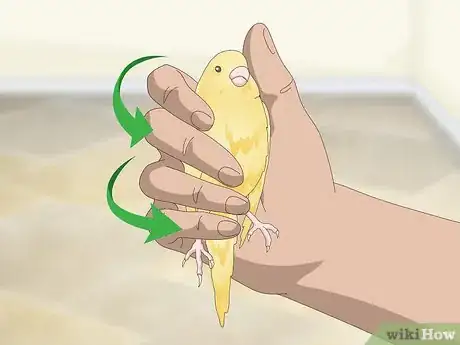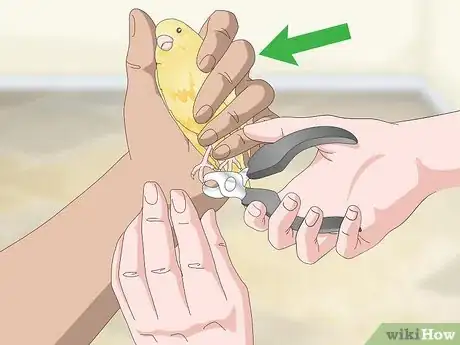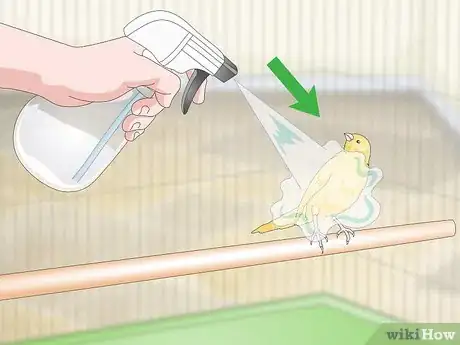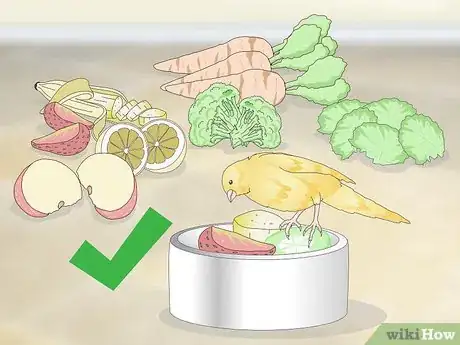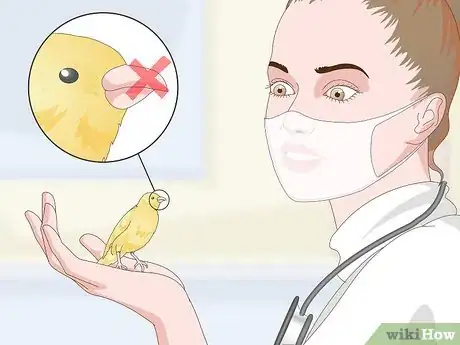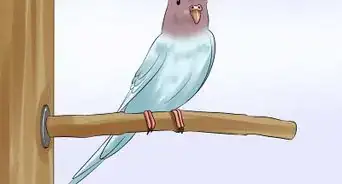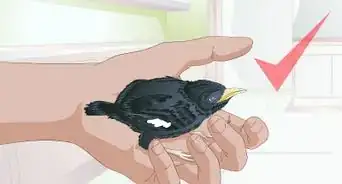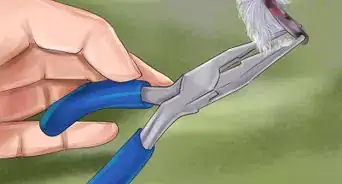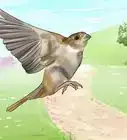This article was co-authored by Melissa Nelson, DVM, PhD. Dr. Nelson is a Veterinarian who specializes in Companion and Large Animal Medicine in Minnesota, where she has over 18 years of experience as a veterinarian in a rural clinic. She received her Doctor of Veterinary Medicine from the University of Minnesota in 1998.
There are 9 references cited in this article, which can be found at the bottom of the page.
This article has been viewed 35,548 times.
Canaries are easy birds to keep groomed because they do most of the work themselves. They love baths, so giving them a bathing dish will ensure that they stay clean. The right toys and perches can help them keep their nails short, but if they get too long, you should take them to the vet.
Steps
Bathing Your Canary
-
1Provide a water dish for bathing. Canaries will bathe themselves, so you don’t have to do anything special to bathe them. Two or more times each week, place a water dish in the canary’s cage so they have water specifically for bathing.[1]
- Choose an appropriate dish. The bathing dish should be sturdy so your canary won’t accidentally flip it over.
- Remove the dish when your canary is finished bathing.
-
2Place around one inch (2.5 cm) of water into the bathing dish. Make sure the water is cooler instead of warmer. Room temperature is fine, but it should not be any hotter, and a bit cooler is better.[2]
- Use filtered, chlorine-free water for bathing.
- Sometimes, canaries will bathe in their water dish. If your canary does this, change the water at least two times each day.
- Clean the water dish periodically with soap and water, making sure that it dries completely. Some people also use a dishwasher and disinfectant. Stainless steel dishes work well, as they clean easily and are very durable.[3]
Advertisement -
3Offer your bird a wet greens bath. You can give your canary a treat while they bathe by placing wet greens into the bathing dish. Wash the greens before placing them in the bathing dish. Your canary can eat the greens while bathing.[4]
- Consider using spinach, baby lettuce, or kale. Avoid comfrey, which can cause liver damage, as well as the leaves from tomato, potato, pepper, eggplant, and rhubarb plants – all of these are toxic.[5]
-
4Allow your bird to dry on its own. Your canary will dry naturally at room temperature. You don’t have to do anything to dry them off. Never use a hair dryer on the bird, because some hair dryers emit dangerous fumes from coatings inside the mechanism that can kill your bird.[6]
Taking Care of Their Nails
-
1Provide plenty of rough surfaces to help keep nails trimmed. Canaries can wear their own nails down by landing on rough concrete or sand perches. Placing these items in the cage can help your bird keep their nails shorter naturally, which means you won’t have to trim them as often.[7]
-
2Take your bird to the vet to get their nails trimmed. The easiest way to trim your canary’s nails is to take them to an avian vet, especially if you find it difficult to trim them yourself. Many bird shops also offer grooming services that include nail trimming.[8]
- If you’re not sure how to trim your bird’s nails, you can cause injury to your bird. It may be better to take them to a professional to keep them safe.
- Your bird's nails are too long if the nail causes the toe not to lie flat on the floor. Nails should also be trimmed to prevent sharp edges.
-
3Grasp the bird properly before trimming the nails. Canaries don’t like to be handled, so you need to hold them properly before starting on the nails. Get another person to hold the bird. Take the bird in your hand, with the bird’s back against your palm. The head should be between the thumb and index finger, or between the index and middle finger.[9]
- Don’t close your hand around the bird’s chest or hold it too tightly. Hold it secure enough so the wings can’t flap and the bird can’t get away.
-
4Trim the nails with the help of another person. If you are going to trim your canary’s nails, always do it with another person. The other person needs to hold the bird while you do the trimming. Use a small nail trimmer to cut the nail.[10]
- Make sure not to cut the quick, which is the red, thick line in the nail. Cut just a little bit of the nail with each snip to make sure you don’t cut too much.
- If you accidentally cut the quick, use styptic powder to stop the bleeding.
Addressing Other Grooming Concerns
-
1Mist your bird during molting. Your canary will go through molting periods during the year. During their moltings, you should mist them daily to help ease any pain from stiff feathers coming in. Use a spray bottle and spray a light mist over the bird’s head so it rains down on them.[11]
- Notice any bald spots during molting. These are not normal and should be checked out by a vet immediately.
-
2Feed your bird a vitamin-rich diet. Your canary should keep themselves groomed on their own. To help keep their feathers, beak, and skin in the best shape, offer a variety of foods that provide vitamins and nutrients. Fresh fruits and veggies, like apples, pears, strawberries, broccoli, cauliflower, carrots, collards, kale, spinach, and watercress are great options.
- During molting, increase your bird’s protein. You can do this by changing to a protein-rich bird seed or by giving them hard-boiled eggs to eat.
- Avoid giving your canary avocado, beetroot, rhubarb, potatoes, cherries, cabbage, eggplant, beans, and onions.
-
3Take your canary to the vet if there are any beak problems. Canaries should not need any at-home grooming of their beaks. Typically, you can provide the bird with a cuttlebone to help keep the beak groomed and prevent it from becoming overgrown. However, if you notice that your canary’s beak is abnormally shaped or uneven, take them to the vet immediately.[12] [13]
References
- ↑ https://www.petco.com/content/petco/PetcoStore/en_US/pet-services/resource-center/caresheets/canary.html
- ↑ http://www.animates.co.nz/media/animates/pet_care/CAre%20guide_Canary.pdf
- ↑ http://www.peteducation.com/article.cfm?c=15+1794&aid=2837
- ↑ http://www.petuniversity.com/birds/canaries-finches/grooming-canaries-finches.htm
- ↑ https://lafeber.com/pet-birds/foods-toxic-pet-birds/
- ↑ http://www.petuniversity.com/birds/canaries-finches/grooming-canaries-finches.htm
- ↑ http://www.petuniversity.com/birds/canaries-finches/grooming-canaries-finches.htm
- ↑ http://www.animates.co.nz/media/animates/pet_care/CAre%20guide_Canary.pdf
- ↑ http://nilesanimalhospital.com/files/2012/05/Handling-and-Grooming-Tips.pdf
About This Article
To keep a canary groomed, provide it with a sturdy water dish for bathing at least 2 times each week. For the best results, make sure to fill the dish with filtered, chlorine-free water until it's about 1 inch deep. You can also offer your canary treats while it bathes, or add some washed spinach, baby lettuce, or kale to the bathing dish for it to eat. In addition to bathing your canary, you can keep its nails worn down to a good length by providing it with plenty of rough surfaces to land on. Alternatively, trim your canary's nails by taking it to the vet or having someone hold it gently while you use a small nail trimmer to cut its nails. For more tips from our Veterinary co-author, including how to address other grooming concerns like molting, scroll down!
